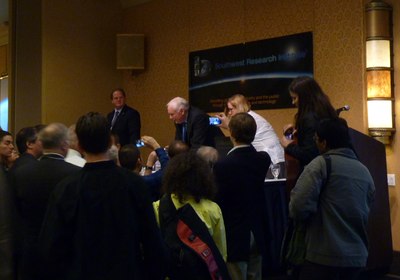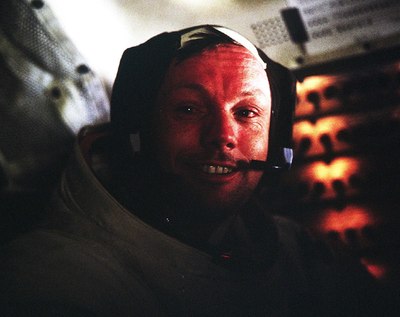Farewell, Mr. Armstrongby Jeff Foust
|
| Sometimes, though, we put a hero up on a pedestal and he stays—even if he never really wanted to be up there in the first place. |
We witnessed a bit of that last week with a former hero by the name of Armstrong. That would be Lance Armstrong, of course, the cyclist who won seven Tour de France competitions after successfully battling cancer, becoming an icon for athletes and cancer patients alike. However, last week Armstrong announced he would no longer contest charges by the US Anti-Doping Agency that he used illicit performance-enhancing drugs during competitions. As a result, he is likely to be stripped of those Tour de France championships and other awards for most of his cycling career.
Sometimes, though, we put a hero up on a pedestal and he stays—even if he never really wanted to be up there in the first place. That was the case with the other Armstrong in the news, Neil Armstrong, who passed away Saturday at the age of 82 after complications from heart surgery earlier in the month. Armstrong may have never considered himself much of a hero, but in the minds of millions around the world, he was.
“As long as there are history books, Neil Armstrong will be included in them, remembered for taking humankind’s first small step on a world beyond our own,” said NASA administrator Charles Bolden, himself a former astronaut, in a statement that echoed many of the platitudes written and spoken in the hours after Armstrong’s death was announced. “Besides being one of America’s greatest explorers, Neil carried himself with a grace and humility that was an example to us all.”
“Neil was among the greatest of American heroes—not just of his time, but of all time,” said President Barack Obama in his own statement about Armstrong’s passing. Armstrong and his Apollo 11 crewmates, Buzz Aldrin and Mike Collins, “set out to show the world that the American spirit can see beyond what seems unimaginable—that with enough drive and ingenuity, anything is possible. And when Neil stepped foot on the surface of the moon for the first time, he delivered a moment of human achievement that will never be forgotten.”
Mitt Romney, running against Obama for the presidency this fall, also weighed in with a brief, almost poetic statement. “Neil Armstrong today takes his place in the hall of heroes. With courage unmeasured and unbounded love for his country, he walked where man had never walked before. The moon will miss its first son of earth.”
One suspects that Armstrong would embarrassed, perhaps, by all the praise heaped upon him by the lofty and the ordinary alike. He was widely regarded as something of a recluse—the J.D. Salinger of space—but that would be inaccurate. He did not seek out the limelight, like some of his fellow former astronauts, but he was active in academia and industry for decades after his historic mission. He was a private individual, to be certain, but someone who chose when and how to speak out and play a role.
| “Neil was among the greatest of American heroes—not just of his time, but of all time,” said President Obama. |
Many of those in the space industry over the years can tell about a brief encounter they had with Armstrong at an event of some kind, and it’s usually a tale of meeting a quiet but gracious individual. In the spring of 1994, during the cavalcade of events leading up to the 25th anniversary of Apollo 11, Armstrong came to MIT to give a lecture about that mission. As you might expect, the largest lecture hall on campus, one usually reserved for freshman physics lectures and movie screenings on the weekends, filled to capacity. That audience included me, as I took a break from my first-year graduate studies to see in person, for the first time, the first man to walk on the Moon.
In that crush of people there was no chance of me getting to meet Armstrong individually, but I had another opportunity. That evening there was a gala dinner at a nearby hotel to honor Armstrong and Aldrin (who got his doctorate from MIT). My first year at MIT was supported by a fellowship by the Massachusetts Space Grant Consortium, which got me an invitation to the dinner and, afterwards, a group photo of all the fellows with Armstrong and Aldrin.
It was around the time of the group photo that I approached Armstrong and did something that, according to conventional wisdom, you’re just not supposed to do. I’m not sure why I did, since I wasn’t interested in collecting them then and still am not today. Maybe I simply didn’t know you weren’t supposed to ask. Or, perhaps, I decided this might be my only opportunity to meet him, and the worst he could do was say no.
I asked him, politely, if a bit nervously, for his autograph.
I don’t recall him saying anything, beyond taking the pen and pad of plain white paper I proffered, signing his name, and returning it to me. I thanked him, and we each went upon our way. That piece of paper is locked away, a treasured memento of a chance encounter.
Six months ago, Armstrong gave the keynote at the Next-Generation Suborbital Researchers Conference in California (see “Has suborbital’s time finally arrived?”, The Space Review, March 5, 2012). He talked about not his experience with Apollo 11, but instead his time as an X-15 test pilot, a topic far more relevant to the audience of suborbital vehicle developer and researchers. He offered a bit of a quiet endorsement for the new generation of commercial suborbital vehicles under development. “There’s a lot of work to be done there, and there’s a lot of opportunity,” he said of suborbital research. “So I certainly hope that some of the approaches that you all are providing now will prove to be profitable and useful.”
 Neil Armstrong greeting attendees of the Next-Generation Suborbital Researchers Conference after his keynote speech there in February 2012. (credit: J. Foust) |
Perhaps more telling, though, was what happened after his talk. He could have easily been ushered out a side door at the conference site, with the explanation that he had another commitment or a plane to catch. But instead he stayed on the podium all through the break that followed his speech, talking with attendees and posing for photos. Hardly the actions of a recluse.
| You’ll hear in many of the tributes to his life the belief that he was a unique individual, and certainly he was. However, many of his essential traits—intelligence, modesty, and grace under pressure—are not as uncommon as we might think them to be. |
For some, though, those actions were not enough: if he had just been a little more out in the public over the years, making the case for space exploration, then perhaps NASA would have a bigger budget or a firmer grasp on its future direction. In recent years he was more outspoken, providing congressional testimony critical to some degree of the Obama Administration’s NASA policy, in particular the plans to cancel Constellation. Yet his words could neither save Constellation nor win it more funding.
Armstrong was also seen by some as anti-commercial space, in part because of a 60 Minutes segment about SpaceX broadcast twice earlier this year (once before and once after the company’s successful Dragon flight to the International Space Station.) But, as noted above, he willingly spoke at a conference focused on the emerging commercial suborbital vehicle industry and applications for such vehicles. Moreover, his comments, like his May 2010 Senate testimony, suggested a more nuanced view. “I support the encouragement of the newcomers toward their goal of lower cost access to space,” he said in his prepared statement. “But having cut my teeth in rockets more than 50 years ago, I am not confident. The most experienced rocket engineers with whom I have spoken believe that will require many years and substantial investment to reach the necessary level of safety and reliability.” Time will tell if that concern was justified.
So while Armstrong may have rejected the notion he was a hero, he was understandably perceived of as one by millions. Yet, he was still very much human, and while he may have stayed on the pedestal society placed him upon after Apollo 11, there was only so much he could—or desired—to do to support the broader cause of space exploration. But it’s hard to slight him for any failings, given all that he accomplished.
You’ll hear in many of the tributes to his life the belief that he was a unique individual, and certainly he was. However, many of his essential traits—intelligence, modesty, and grace under pressure—are not as uncommon as we might think them to be. It’s quite possible that the next person to set foot on the Moon, or the first man or woman to land on an asteroid or walk on the red sands of Mars, will share some or all of Armstrong’s defining characteristics, essential as they are, ultimately, to the future human exploration of the solar system.
